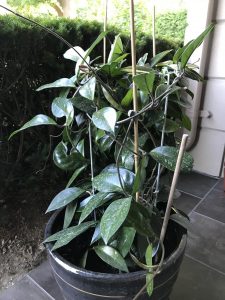
I have had a Hoya plant (see photo, looks healthy / keeps growing) for 6~7 years, started with a stem cut. But it has not had any sign of flowering. I had it indoor until about a month ago, and I thought gave it a try by leaving it in my porch (basically outdoor but not fully exposed).
Need to ask about Hoya flowering?
Hello Hoya owner,
While it is sometimes relatively easy to maintain the general well-being and growth of a tropical plant in an indoor environment, the most common concern is often the inability to bring the plant to flower. You are not alone. The Hoya is a member of a sub-family of Asciepiadaceae, commonly known as milkweed. And so your decision to bring your Hoya plant outdoors during the summer months was good instinct, for the temperate, humid weather in this south-central region of Ontario is not unlike that of tropical Asian and Australian climes to which it is native. But after 6 years-plus indoors, your plant likely could use a refresher.
Most Hoya, evergreen perennials, are ‘epiphytic’, i.e. they grow on the surfaces of other plants. Epiphytes make very good indoor house plants, because they require minimal planting medium, and water. As your picture shows, Hoya (also referred to as ‘wax plant’, or ‘wax vine’) have fleshy, dark green, smooth leaves. If this description sounds vaguely like that of the leaves of orchids (like the phalaenopsis orchids readily available in corner stores) then you are correct, as orchids are also epiphytic.
Now that this connection has been made, the basics of Hoya-care become a bit more straightforward: (1) choose a pot that will be just large enough to hold the root system (cut away any rotted root material), with good drainage hole(s) and add a separate saucer underneath. (2) Hoya really do not appreciate a soil-filled pot: instead plant in a mix of large-chunk orchid bark and 25% Perlite (water-absorbant), and allow your Hoya to become what would be otherwise considered as ‘root bound’. (3) Take care to not over water, to avoid rotting the roots. Let the mixture really dry out before watering, then apply room temperature water from the top, allow to sit overnight, and discard all water that has drained into the saucer. This is important. (4) Light: your Hoya will need 2-4 hours of direct sunlight a day, preferably a southerly facing window; for the balance of the day offer bright, but in-direct sunlight (could be a sheer curtain drawn over the window): never direct sun all day, as leaves can easily be badly sun-scorched. (5) Fertilizer: choose a soluble fertilizer suitable for orchids: look for the numbers: 5-10-5. High in phosphorus. Mix with water according to the directions: never guess. This will promote root, not leaf, growth. The root system will soon become robust enough to send more nutrients up to the plant, which in turn will eventually be strong enough to form blossoms, clusters of umbrella-shaped, musky-fragrant, flowers. (6) Lastly, give your Hoya a rest period during the winter: pull back on the fertilizer and light, and come spring you can revitalize its renewed growth.
P.S. One last thought: I see you’ve tied your plant to keep the stems upright: but you may wish to consider, as mentioned earlier, that your Hoya is a vine, and would likely do very well in a hanging pot; or place your pot on a stool or small stand, and allow the stems to grow freely, downwards and sideways.
For your further reading, here is link to a Toronto Master Gardener reply to another gardener writing regarding their Hoya flowering.
Also, for more inspiration, you may wish to take a look around at the site of the International Hoya Association.

